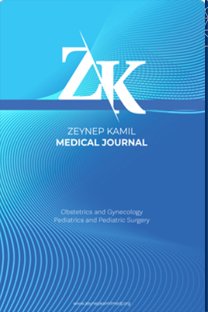Effect of COVID-19 on anesthesia preferences in cesarean section: An observational study
Effect of COVID-19 on anesthesia preferences in cesarean section: An observational study
___
- 1. World Health Organization. World health Statistics 2015: Geneva: World Health Organization; 2015. Available at: https://www.who.int/ docs/default-source/gho-documents/world-health-statistic-reports/ world-health-statistics-2015.pdf. Accessed May 18, 2020.
- 2. Bıyık İ, Aslan MM. The effects of antenatal education on fear of childbirth and cesarean rates. Kocaeli Med J 2020;9:77–82.
- 3. Aksoy M, Aksoy AN, Dostbil A, Çelik MG, Ahıskalıoğlu A. Anaesthesia techniques for caesarean operations: Retrospective analysis of last de- cade. Turk J Anesth Reanim 2014;42:128–132.
- 4. Sahinturk H, Turhan S, Can SO, Yılmaz AA, Uysalel A. Factors affecting anaesthesia preferences of the gravid women who are to deliver by cae- sarean section. Sanamed 2019;14:13–20.
- 5. Zaigham M, Andersson O. Maternal and perinatal outcomes with COVID -19: A systematic review of 108 pregnancies. Acta Obstet Gyne- col Scand 2020;99:823–9.
- 6. Dashraath P, Wong JLJ, Lim MXK, Lim LM, Li S, Biswas A, et al. Corona- virus disease 2019 (COVID-19) pandemic and pregnancy. Am J Obstet Gynecol 2020;222:521–31.
- 7. Chen R, Zhang Y, Huang L, Cheng BH, Xia ZY, Meng QT. Safety and efficacy of different anesthetic regimens for parturients with COVID-19 undergoing Cesarean delivery: A case series of 17 patients. Can J An- aesth 2020;67:655–63.
- 8. Kim WH, Hur M, Park SK, Yoo S, Lim T, Yoon HK, et al. Comparison be- tween general, spinal, epidural, and combined spinal-epidural anesthe- sia for cesarean delivery: A network meta-analysis. Int J Obstet Anesth 2019;37:5–15.
- 9. Arslan B, Ozturk NK, Onuk ZAA, Karsli B. Factors affecting selection of anesthesia type in elective cesarean operations and pregnant prefer- ences for anesthesia outcome. Med Sci 2019;8:113
- 10. World Health Organization. Infection prevention and control of epidem- ic- and pandemic-prone acute respiratory infections in health care. Available at: https://www.who.int/publications/i/item/infection-preven- tion-and-control-of-epidemic-and-pandemic-prone-acute-respiratory-in- fections-in-health-care. Accessed May 18, 2022.
- 11. Harrison L, Ramsden J, Winter S, Rocke J, Heward E. Guidance for surgical tracheostomy and tracheostomy tube change during the COVID-19 pandemic. Available at: https://www.ahns.info/wp-content/ uploads/2020/03/Guidance-for-Surgical-Tracheostomy-and-Tracheos- tomy-Tube-Change-during-the-COVID.pdf. Accessed May 18, 2022.
- 12. Bauer ME, Bernstein K, Dinges E, Delgado C, El-Sharawi N, Sultan P, et al. Obstetric anesthesia during the COVID-19 pandemic. Anesth Analg 2020;131:7-15.
- 13. Bauer ME, Chiware R, Pancaro C. Neuraxial procedures in COVID-19-positive parturients: A review of current reports. Anesth Analg 2020;131:e22-4.
- 14. Lippi G, Plebani M, Henry BM. Thrombocytopenia is associated with se- vere coronavirus disease 2019 (COVID-19) infections: A meta-analysis. Clin Chim Acta 2020;506:145-8.
- 15. Altiparmak B, Korkmaz Toker M, Uysal AI, Gümüş Demi Rbi Lek S. Re- gional anesthesia in patients with suspected COVID-19 infection. Reg Anesth Pain Med 2021;46:91-2.
- 16. Lee LO, Bateman BT, Kheterpal S, Klumpner TT, Housey M, Aziz MF, et al. Risk of epidural hematoma after neuraxial techniques in thrombo- cytopenic parturients: A report from the multicenter perioperative out- comes group. Anesthesiology 2017;126:1053-63.
- ISSN: 1300-7971
- Yayın Aralığı: Yılda 4 Sayı
- Yayıncı: Ali Cangül
Ayça ÖZGÜREL BOZKURT, Nazan USAL TARHAN, Enis ÖZKAYA
Serum follistatin-like-3 levels in the diagnosis of tubal ectopic pregnancy
Işıl AYHAN, Ahter Tanay TAYYAR, İsmail DAĞ, Melike ALTINTAŞ, Hakan BİLGESOY, Betül YILMAZER
Fetal megacystis at 11–14 weeks of gestation: 3-year experience of a tertiary center
Gökhan BOLLUK, Özge ÖZDEMİR, Burak DEMİRDELEN
Serkan ORAL, Alper ŞİŞMANOĞLU, Yaşam Kemal AKPAK, Sebahattin ÇELİK, Nazan YURTÇU
Evaluation of voiding functions with the micturition video: The preliminary results
Tuğçe Merve ORBAY, Ayşenur CELAYİR, Cengiz GÜL, Bekir ERDEVE
Surgical treatment of the rectal prolapse in children: A review
Cengiz GÜL, Sabri CANSARAN, Ayşenur CELAYİR
Evaluation of the relationship between dental caries and urinary tract infections
Fedli Emre KILIÇ, Habip ALMİŞ, İbrahim Hakan BUCAK, Mehmet TURGUT
Effect of COVID-19 on anesthesia preferences in cesarean section: An observational study
Meryem ONAY, Sema ŞANAL BAŞ, Ümit AKKEMİK, Ayten BİLİR
Kutlay GÜR, Nihan UYGUR KÜLCÜ, Özlem ERDEDE, Erdal SARI, Rabia Gönül SEZER YAMANEL, Abdulkadir BOZAYKUT
Nihan UYGUR KÜLCÜ, Züleyha Aysu SAY, Habibe AYVACI TAŞAN, Handan ÇETİNER, Zeynep Gamze KILIÇOĞLU
